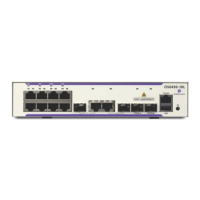OmniSwitch AOS Release 7 Network Configuration Guide March 2011 page 151
15 Configuring RIP
Routing Information Protocol (RIP) is a widely used Interior Gateway Protocol (IGP) that uses hop count
as its routing metric. RIP-enabled routers update neighboring routers by transmitting a copy of their own
routing table. The RIP routing table uses the most efficient route to a destination, that is, the route with the
fewest hops and longest matching prefix.
The switch supports RIP version 1 (RIPv1), RIP version 2 (RIPv2), and RIPv2 that is compatible with
RIPv1. It also supports text key and MD5 authentication, on an interface basis, for RIPv2.
In This Chapter
This chapter describes RIP and how to configure it through the Command Line Interface (CLI). It includes
instructions for configuring basic RIP routing and fine-tuning RIP by using optional RIP configuration
parameters (e.g., RIP send/receive option and RIP interface metric). It also details RIP redistribution,
which allows a RIP network to exchange routing information with networks running different protocols
(e.g., OSPF and BGP). CLI commands are used in the configuration examples; for more details about the
syntax of commands, see the OmniSwitch CLI Reference Guide.
This chapter provides an overview of RIP and includes information about the following procedures:
• RIP Routing
– Loading RIP (see page 15-6)
– Enabling RIP (see page 15-7)
– Creating a RIP Interface (see page 15-7)
– Enabling a RIP Interface (see page 15-7)
• RIP Options
– Configuring the RIP Forced Hold-Down Interval (see page 15-9)
– Configuring the RIP Update Interval (see page 15-9)
– Configuring the RIP Invalid Timer (see page 15-10)
– Configuring the RIP Garbage Timer (see page 15-10)
– Configuring the RIP Hold-Down Timer (see page 15-10)
– Enabling a RIP Host Route (see page 15-11)
• RIP Redistribution
– Configuring Route Redistribution (see page page 15-12)
• RIP Security
– Configuring Authentication Type (see page 15-18)
– Configuring Passwords (see page 15-18)

